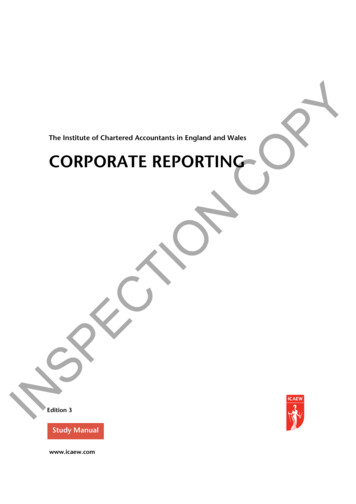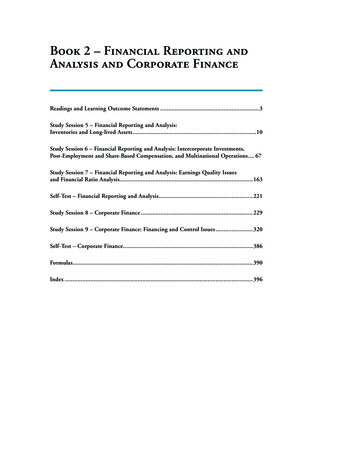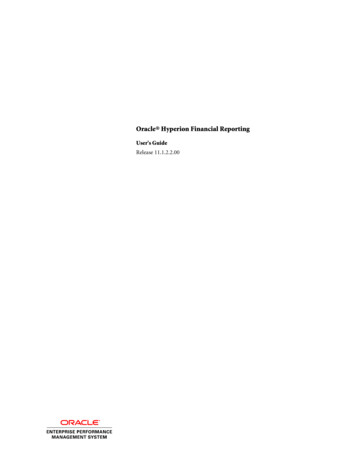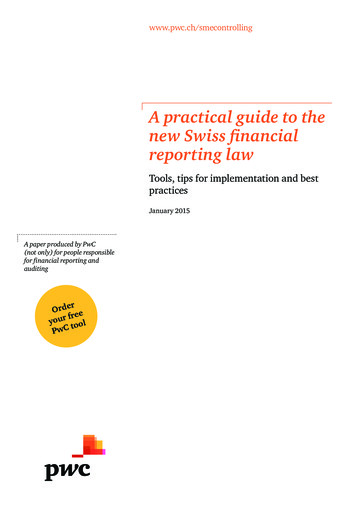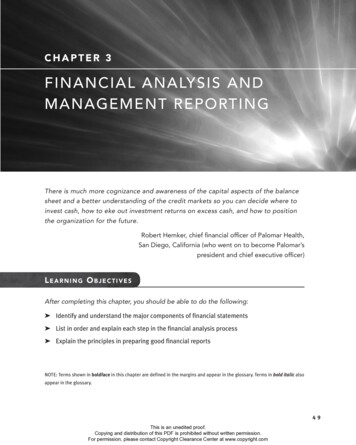
Transcription
CHAPTER 3FINANCIAL ANALYSIS ANDMANAGEMENT REPORTINGThere is much more cognizance and awareness of the capital aspects of the balancesheet and a better understanding of the credit markets so you can decide where toinvest cash, how to eke out investment returns on excess cash, and how to positionthe organization for the future.Robert Hemker, chief financial officer of Palomar Health,San Diego, California (who went on to become Palomar’spresident and chief executive officer)Learning ObjectivesAfter completing this chapter, you should be able to do the following: Identify and understand the major components of financial statements List in order and explain each step in the financial analysis process Explain the principles in preparing good financial reportsNOTE: Terms shown in boldface in this chapter are defined in the margins and appear in the glossary. Terms in bold italic alsoappear in the glossary.49This is an unedited proof.Copying and distribution of this PDF is prohibited without written permission.For permission, please contact Copyright Clearance Center at www.copyright.com
50Introduction to the Financial Management of Healthcare OrganizationsI n t r o d u c ti o nFinancial analysis and management reporting are integral parts of the management functions of control and financial management. Financial analysis includes methods used byinvestors, creditors, and management to evaluate the past, present, and future financialperformance of a healthcare organization. On completion of the analysis, the informationis reported to the appropriate stakeholders, inside and outside the organization, at whichtime the stakeholders take action in the form of decisions.StepsinF i n a n ci a l A nalys i sFinancial analysis includes the following three steps:horizontal analysisEvaluation of the trendsin an organization’sfinances by focusingon percentage changeover time.vertical analysisEvaluation of theinternal structure ofan organization byfocusing on a basenumber and showingpercentages ofimportant line itemsin relation to the basenumber.1.Establish the facts about the organization.2.Compare the facts about the organization over time and to facts about similarorganizations.3.Use perspective and judgment to make decisions regarding the comparisons.Financial analysis by management can occur at any level—departmental, divisional,or organizational—within the organization.At the organizational level, establishing the facts (the first step) usually relates to areview of the organization’s key financial statements, including the balance sheet, statementof operations, statement of changes in net assets, and statement of cash flows. As recommended by the American Institute of Certified Public Accountants (AICPA), healthcareorganizations with permanent controlling financial interests in other healthcare organizations should prepare consolidated financial statements to properly report the relationship(AICPA 2012). Before they undertake financial analysis, investors and creditors may requirethat independent auditors review the financial statements to confirm their accuracy.The second step, comparing the facts in the organization over time and to facts inother, similar organizations, includes ratio analysis, horizontal analysis, and vertical analysis.Ratio analysis, which was introduced in chapter 1, evaluates an organization’s performanceby computing the relationships of important line items found in the financial statements.There are four kinds of ratios: liquidity, profitability, activity, and capital structure.Horizontal analysis evaluates the trend in the line items by focusing on the percentage change over time. Vertical analysis evaluates the internal structure of the organizationby focusing on a base number and showing percentages of important line items in relationto the base number. When ratio analysis, horizontal analysis, and vertical analysis have beencompleted, the organization can compare present ratios, trends, and percentages to its pastratios, trends, and percentages. The organization can also develop industry comparisonsThis is an unedited proof.Copying and distribution of this PDF is prohibited without written permission.For permission, please contact Copyright Clearance Center at www.copyright.com
Chapter 3: Financial Analysis and Management Reporting51that compare the organization’s present ratios, trends, and percentages to those of other,similar organizations.1The third step of financial analysis, using perspective and judgment to make decisions, takes into account the information obtained in the first two steps, in addition toinformation derived from the decision maker’s unique perspective and judgment, to makethe decision. Decisions that may at first appear to be contrary to the information providedin the first two steps may make perfect sense based on pressures from internal and externalconstituents, including medical staff, employers, regulators, donors, and others.The example of a fictional facility, Bobcat Hospital, will be used to illustrate thefinancial analysis concepts in this chapter.Balance SheetThe balance sheet shows the organization’s financial position at a specific point in time,typically at the end of an accounting period (see exhibit 3.1). The balance sheet presentsthe organization’s assets, liabilities, and net assets (or shareholders’ equity in for-profit organizations) and its relationships, which are reflected in the following accounting equation:Assets Liabilities Net AssetsAssets are economic resources that provide or are expected to provide benefit to theorganization. Current assets are economic resources that have a life of less than one year(i.e., the organization expects to consume them within one year). Current assets are listedon the balance sheet in order of liquidity. Cash is money on hand and in the bank that theorganization can access immediately. Temporary investments consist of money placed insecurities with maturities up to one year, such as commodities and options. The categoryreceivables, net—made up of patient accounts receivable, net of allowances for contractualallowances, charity care, and bad debt—represents money due to the organization frompatients and third parties for services already provided. Inventory is the cost of food, fuel,drugs, and other supplies purchased by the hospital but not yet used or consumed. Prepaidexpenses are expenditures made by the hospital for goods and services not yet consumedor used in hospital operations (sometimes referred to as deferred expenses), such as rent andinsurance premiums.Noncurrent assets are economic resources that have a life of one year or more (i.e.,the organization expects to consume them over a span longer than one year). Plant andequipment, net consists of economic resources, such as land, buildings, and equipment,minus the amount that has been depreciated over the life of the buildings and equipment(which is called accumulated depreciation). Long-term investments are economic resourcesthat the hospital owns, such as corporate bonds and government securities, and intendsThis is an unedited proof.Copying and distribution of this PDF is prohibited without written permission.For permission, please contact Copyright Clearance Center at www.copyright.comassetsEconomic resourcesthat provide or areexpected to providebenefit to theorganization.
52Exhibit 3.1Bobcat HospitalBalance Sheet, asof December 312017, 2016(in thousands)Introduction to the Financial Management of Healthcare Organizations20172016ASSETSCurrent assetsCashTemporary investmentsReceivables, netInventoryPrepaid expensesTotal current assets 124453,536175323,912Noncurrent AssetsProperty, plant, and equipmentAccumulated depreciationNet property, plant, and equipmentLong-term investmentsOther noncurrent assetsTotal noncurrent 9209901096,019Total assets9,88410,226LIABILITIES & NET ASSETSCurrent liabilitiesAccounts payableNotes payableAccrued expenses payableDeferred revenuesEstimated third-party adjustmentsCurrent portion of long-term debtTotal current liabilities 302345871101371841,849 nt liabilitiesLong-term debt, less current portion3,6003,500Total liabilities5,4495,030NET ASSETSUnrestricted net assetsTemporarily restricted net assetsPermanently restricted net assets3,2857504003,896700600Total net assets4,4355,196 9,884 10,226Total liabilities and net assetsThis is an unedited proof.Copying and distribution of this PDF is prohibited without written permission.For permission, please contact Copyright Clearance Center at www.copyright.com
Chapter 3: Financial Analysis and Management Reportingto hold for more than one year. Other noncurrent assets include assets limited as to use(by contracts with outside parties) and goodwill which represents the amount above fairmarket value based on an entity’s future earning potential.Liabilities are economic obligations, or debts, of the organization. Current liabilities are economic obligations, or debts, that are due within one year. Accounts payableare amounts the organization owes to suppliers and other trade creditors for merchandiseand services purchased from them, but for which the organization has not yet paid. Notespayable are short-term obligations for which a formal contract has been signed, such asa short-term loan. Accrued expenses payable are liabilities for expenses that have beenincurred by the hospital but for which the hospital has not yet paid, such as compensationto employees. Deferred revenue is money received by the hospital but not yet earned by thehospital, such as registration fees for an educational program not yet provided. Estimatedthird-party adjustments are approximations of how much money the organization willbe required to return to third-party payers due to overpayments to the organization. Current portion of long-term debt is the amount of the organization’s long-term debt (notincluding interest) that is expected to be paid within one year.Long-term liabilities are economic obligations, or debts, that are due in more thanone year. Long-term debt, net of current portion is an economic obligation, or debt, thatis due in more than one year, minus the amount that is due within one year.Net assets is the current American Institute of Certified Public Accountants(AICPA)–approved term for the difference between assets and liabilities in not-for-profithealthcare organizations2 and represents the owner’s (community’s or religion’s) and others’(donors external to the organization) financial interest in the organization. Unrestricted netassets include net assets that have not been externally restricted by donors or grantors, suchas the excess of revenues to expenses from operations. Unrestricted net assets include netassets that are contractually limited by the governing body, such as proceeds of debt issues,funds deposited with a trustee and limited to use by an indenture agreement, and funds setaside under self-insurance arrangements and statutory reserve requirements. Temporarilyrestricted net assets include donor-restricted net assets that the organization can use forthe donor’s specific purpose after the organization has met the donor’s restriction, such asthe passage of time or an action by the organization. Permanently restricted net assetsinclude donor-restricted net assets with restrictions that never expire, such as endowmentfunds. In fiscal years beginning after December 15, 2017, organizations will be expected topresent net assets in two categories instead of three: “net assets without donor restrictions”and “net assets with donor restrictions”. Generally accepted accounting principles (GAAP)will require organizations to disclose the amount, purpose, and type of board restrictionsfor net assets without donor restrictions, and GAAP will require organizations to disclosethe nature and amount of donor restrictions for net assets with donor restrictions (Connorand Mosrie 2016).This is an unedited proof.Copying and distribution of this PDF is prohibited without written permission.For permission, please contact Copyright Clearance Center at www.copyright.com53liabilitiesEconomic obligations,or debts, of theorganization.net assetsThe difference betweenassets and liabilitiesin a not-for-profitorganization, whichrepresents the owner’sand others’ financialinterests in theorganization.
54Introduction to the Financial Management of Healthcare OrganizationsShareholders’ equity is the current AICPA-approved term for the difference betweenassets and liabilities in for-profit healthcare organizations; it represents the ownership interestof stockholders in the organization. Shareholders’ equity is also called stockholders’ equity,owners’ equity, or net worth and comprises common stock and retained earnings. Commonstock is money invested in the organization by its owners. Retained earnings result fromincome earned by the organization from operations minus dividends (distributions of earnings paid to stockholders based on the number of shares of stock owned).Explanatory notes for the balance sheet and the other financial statements shouldidentify extraordinary events, as well as certain required provisions, and should be presentedfollowing the financial statements. In fiscal years beginning after December 15, 2018, publicorganizations and not-for-profit organizations that have issued securities which are tradedor listed on an exchange or over-the-counter market will be expected to present the effectsof all leases on the balance sheet (the deadline for all other organizations is fiscal yearsbeginning after December 15, 2019). ASU 2016-02, Leases (Topic 842) intends to increasetransparency and comparability among organizations by requiring all organizations, not justhealthcare organizations, to present the effects of both financial leases and operating leaseson the balance sheet (historically, organizations have not presented the effects of operatingleases on the balance sheet). The organization should recognize a liability (lease payments)and a right-of-use asset on the balance sheet (Connor and Mosrie 2016).S tat e m e n tofO p e r at i o n sThe statement of operations, called the income statement in for-profit organizations, summarizes the organization’s net revenues, expenses, and excess of net revenues over expenses(called income before taxes in a for-profit organization) over a period of time (see exhibit 3.2).The relationship of the statement of operations to the balance sheet can be best expressedby the following expanded accounting equation:Assets Liabilities Net Assets (Net Revenue – Expenses)revenuesThe amounts earnedby the organization orsometimes donatedto it.where the permanent accounts of the balance sheet, which are accounts that carrybalances forward to the next year, relate to the temporary accounts of the statement ofoperations, which are accounts that zero out at the end of each year. To zero out the netresults of the statement of operations at the end of the year, the net results are transferredto unrestricted net assets on the balance sheet (or to retained earnings on the balance sheetof a for-profit organization).Revenues are the amounts earned by organization or sometimes donated to it.Gross patient services revenues are the total amount of charges for patients utilizing thehospital, regardless of the amount actually paid. Deductions from gross patient servicesThis is an unedited proof.Copying and distribution of this PDF is prohibited without written permission.For permission, please contact Copyright Clearance Center at www.copyright.com
Chapter 3: Financial Analysis and Management ReportingREVENUESGross patient services revenue (non-GAAP)Provision for contractualadjustments (non-GAAP)Provision for charity care (non-GAAP)Net patient services revenueProvision for bad debt allowanceNet patient services revenue less provisions for baddebtPremium revenueOther operating revenueTotal operating revenue20172016 13,031–4,209–4208,402–6007,802 12,610–4,083–4088,119–4,7637,643400440 8,6420447 2–696EXPENSESSalaries, wages, and benefitsSupplies, drugs, purchased servicesDepreciation and amortizationInterestTotal operating expensesOPERATING INCOMENON OPERATING INCOMEInvestment incomeEXCESS OF REVENUE OVER EXPENSESUnrestricted net assetsTemporarily restricted net assetsPermanently restricted net assets 95 85933,285750400–6113,8967006004,4355,196CHANGES IN NET ASSETSTotal changes in net assetsrevenues include amounts deducted from total charges to account for contractual allowances and charity care.Net patient services revenue is money generated by providing patient care minusthe amount the organization will not collect as a result of discounting charges per contractual agreement and providing charity care. For financial reporting purposes, patientservices revenue does not include provisions for charity care because charity care was neverintended to result in cash flow. GAAP in 2010 required that organizations report theamount of charity care recorded at cost along with the method of determining cost andThis is an unedited proof.Copying and distribution of this PDF is prohibited without written permission.For permission, please contact Copyright Clearance Center at www.copyright.com55Exhibit 3.2Bobcat HospitalStatement ofOperations(in thousands)through December31, 2017, 2016
56expensesAmounts of resourcesused by theorganization.Introduction to the Financial Management of Healthcare Organizationsthe organization’s charity care policy in notes to the financial statements. (Bad debt is theaccounting recognition of how much money the organization has billed but will not collect; the amount reported must be based on charges. Bad debt should not be confused withcharity care. Bad debt expense reflects the amount for which the organization providedservices with the expectation of payment. Charity care reflects services the organizationprovided with no expectation of payment.)Net patient services revenue minus provisions for bad debt includes net patient servicerevenue minus the amount the organization will not collect as a result of bad debt. In 2012GAAP moved bad debt from an operating expense to a deduction of revenue to accountfor the patient’s inability to pay deductibles for high-deductible health policies (which theorganization knows at time of service). In 2016 the AICPA Revenue Recognition Task Forcefor Healthcare proposed, but did not require, new guidance for presenting bad debt. Afterrecording revenue at the amount the organization expects to be paid, bad debt would thenbe recognized in two categories: classic bad debt (the organization believes the patient isable to pay, but the patient does not pay) would be recorded as a bad debt expense underoperating expenses; and an implicit price concession (the organization believes the patient isunable to pay, but the patient is not eligible for charity care, and the organization recognizes a write-off based on internal policy). The proposed new guidance for presenting baddebt would allow organizations to group patients with similar characteristics, such as trueself-pay or high deductible (Connor and Mosrie 2016).Premium revenue is money generated from capitation arrangements that must bereported separately from patient services revenue because premium revenue is earned byagreeing to provide care, regardless of whether care is ever delivered. Other operating revenueis money generated from services other than health services to patients and enrollees. It mayinclude revenue from rental equipment and office space, sales of supplies and pharmaceuticals, cafeteria and gift shop sales, and so on. Often the test for whether revenue is consideredother operating revenue or nonoperating revenue is whether the revenue was generated insupport of the organization’s mission statement. Why is it important to distinguish betweenoperating and nonoperating revenue? Because for a not-for-profit hospital, income derivedfrom operations is not taxed, but income from unrelated businesses, such as the gift shop,may be taxed as unrelated business income. Net assets released from restrictions used foroperations, while not reflected in Bobcat Hospital’s statement of operations, consist ofmoney previously restricted by donors that has become available for operations.Expenses are the amounts of resources used by the organization. The category ofoperating expenses represents resources used on operations to generate revenue in supportof the organization’s mission statement. These expenses can be listed by functional classification (organizational division), such as nursing department and support department,which is useful for internal purposes, or by natural classification, under such as categoriesas salaries, wages, and benefits or supplies, drugs, and purchased services, as is the case withBobcat Hospital’s statement of operations, which is useful for external purposes.This is an unedited proof.Copying and distribution of this PDF is prohibited without written permission.For permission, please contact Copyright Clearance Center at www.copyright.com
Chapter 3: Financial Analysis and Management ReportingThe category depreciation and amortization reflects the expensing of long-termassets over time to show their declining value. Interest is the expense incurred with borrowed money. Other operating expenses are miscellaneous expenses that have not beenreported elsewhere.Operating income is the money earned from providing patient care services andincludes the total revenue, gains, and other support minus the total operating expenses.Nonoperating income is the money earned from non–patient care services, such as investment income, as shown on Bobcat Hospital’s statement of operations.Excess of revenues over expenses (or net income in for-profit organizations) is theoperating income plus the nonoperating income minus total expenses. For not-for-profitorganizations, AICPA requires excess of revenues over expenses to be reported as the performance indicator that reflects the results of operations. Not-for-profit organizations mustreport the performance indicator in a statement of operations that also presents the totalchanges in unrestricted net assets. The notes to the financial statements should provide adescription of the nature and composition of the performance indicator (AICPA 2012).57operating incomeMoney earned fromproviding patient careservices. It includesthe total revenue,gains, and othersupport minus the totaloperating expenses.excess of revenuesover expensesOperating income plusnonoperating incomeminus total expenses.S tat e m e n tofChangesinNet AssetsThe statement of changes in net assets, called the statement of equity in a for-profit organization, shows the reasons why net assets changed from the beginning of the statementperiod to the end of the statement period as reported in summary fashion on the balancesheet. Because AICPA requires not-for-profit organizations to report changes of unrestrictednet assets on the statement of operations, many organizations also include changes in temporarily restricted and permanently restricted net assets on the statement of operations,which eliminates the need for a separate statement of changes in net assets. This statementis important in showing how the changes in the excess of revenues over expenses affect thenet asset, or equity, position of the organization (as was shown in the example in exhibit3.2).Unrestricted net assets come directly from the statement of operations and havealready been explained in that section. The category temporarily restricted net assets presentsthe changes in temporarily restricted net assets during the statement period. Within thiscategory (and not shown in exhibit 3.2) are several subcategories: The subcategory contributions for charity care represents money donated to the hospital for the provision of charitycare. Net realized and unrealized gains on investments reflects an increase in the value of theinvestment (unrealized until sold) and an increase in cash (realized through dividends orinterest). Net assets released from restrictions includes money previously restricted by donorsthat has become available for use. Increase (decrease) in temporarily restricted net assets presentsthe total changes in temporarily restricted net assets during the statement period.The category permanently restricted net assets presents the changes in permanentlyrestricted net assets during the accounting period. Within this category (and not shown inexhibit 3.2) are several subcategories. Contributions for endowment funds includes moneyThis is an unedited proof.Copying and distribution of this PDF is prohibited without written permission.For permission, please contact Copyright Clearance Center at www.copyright.com
58Introduction to the Financial Management of Healthcare Organizationsreceived from donors with permanent restrictions on the principal and interest. Net realized and unrealized gains on investments represent an increase in value of the investmentand an increase in cash.The final total changes in net assets is the difference between total net assets at thebeginning of the year and total net assets at the end of the year. In exhibit 3.2, this lineshows an increase in Bobcat Hospital’s total net assets.S tat e m e n tofCash FlowsThe statement of cash flows shows the organization’s cash flow—that is, the amounts ofcash receipts and where they came from and the amounts of cash disbursements and wherethey went during the statement period (see exhibit3.3; notes for the statement are shownin exhibit 3.4 that follows). In a not-for-profit organization, the statement is divided intocash flow from operations, cash flow from investments, and cash flow from financing,including restricted income and contributions. For-profit organizations do not divide thecash flows into categories, but the bottom line is the same—net increase (decrease) in cash.3Cash flow from operating activities begins with the change in net assets (this figurecomes from the statement of changes in net assets or is computed from the difference intotal net assets between statement periods) and then includes the changes in cash betweenstatement periods for providing patient care services. Information from the statement ofoperations was prepared using accrual accounting, as required by GAAP. This means thatrevenues were recorded when the services were billed, not when the bills were paid. Expenseswere recorded when they contributed to operations, not when they were paid. Revenues andexpenses must be adjusted as well as noncash events, such as depreciation. The remainderof this section of the statement of cash flows makes the necessary adjustments.Cash flow from investing activities includes the changes in cash between statementperiods for investing in fixed assets, such as property and equipment, and for selling fixedassets. Cash flow from financing activities includes the changes in cash between statementperiods for financing activities—such as debts, endowments, grants, and transfers—to andfrom parent organizations.Net increase (decrease) in cash and cash equivalents is computed by adding the netcash from operating, investing, and financing activities.Cash and cash equivalents, beginning of year corresponds with the cash and cashequivalents, end of year for the previous year. Cash and cash equivalents, end of year is computed by adding the net increase (decrease) in cash and cash equivalents to the cash andcash equivalents, beginning of year, and corresponds to cash and cash equivalents on thebalance sheet for the same statement period.This is an unedited proof.Copying and distribution of this PDF is prohibited without written permission.For permission, please contact Copyright Clearance Center at www.copyright.com
Chapter 3: Financial Analysis and Management Reporting2017Cash flow from operating activitiesChange in net assetsAdjustments to reconcile change in net assets to net cash provided byoperating activitiesExtraordinary loss from extinguishment of debtDepreciation and amortizationNet realized and unrealized gains on investmentsTransfer to parentProvisions for bad debt(Increase) decrease in:Patient accounts receivableTrading securitiesOther current assetsOther assets (384)4710060018102747Increase (decrease) in:Accounts and notes payableAccrued expenses payableEstimated third-party settlementsOther current liabilitiesOther liabilitiesNet cash flow from operating activities–58463–9261001,361Cash flow from investing activitiesPurchase of investmentsCapital expendituresNet cash flow from investing activities–1,413–1,413Cash flow from financing activitiesTransfers to parentProceeds from restricted contributions and restricted investmentsincomePayments on long-term debtPayments on capital lease obligationsProceeds from issuance of long-term debtNet cash flow from financing activities–18400–89Net increase (decrease) in cash and cash equivalents–141095Cash and cash equivalents at the beginning of the year310Cash and cash equivalents at the end of the year169This is an unedited proof.Copying and distribution of this PDF is prohibited without written permission.For permission, please contact Copyright Clearance Center at www.copyright.com59Exhibit 3.3Bobcat HospitalStatement of CashFlows, 2017
60Introduction to the Financial Management of Healthcare OrganizationsExhibit 3.4Bobcat HospitalNotes to FinancialStatements 20171. Organization and Nature of OperationsBobcat Hospital is a 120 bed, nonprofit hospital offering the following services:inpatient, outpatient, emergency, long-term care, rehab, and home care.2. Community Benefit and Charity CareBobcat Hospital provides healthcare services through various programs that aredesigned to enhance the health of
Introduction to the Financial Management of Healthcare Organizations. I. ntroductIon. Financial analysis and management reporting are integral parts of the management func-tions of control and financial management. Financial analysis includes methods used by investors, creditors, and management to evaluate

